An official website of the United States government
 United States Department of Labor
United States Department of Labor
Set up and operate a variety of machine tools to produce precision parts and instruments out of metal. Includes precision instrument makers who fabricate, modify, or repair mechanical instruments. May also fabricate and modify parts to make or repair machine tools or maintain industrial machines, applying knowledge of mechanics, mathematics, metal properties, layout, and machining procedures. Machinists who primarily program or operate computer numerically controlled (CNC) equipment are classified in “Computer Numerically Controlled Tool Operators and Programmers” (51-9160).
Employment estimate and mean wage estimates for Machinists:
| Employment (1) | Employment RSE (3) |
Mean hourly wage |
Mean annual wage (2) |
Wage RSE (3) |
|---|---|---|---|---|
| 333,220 | 0.9 % | $ 23.57 | $ 49,020 | 0.3 % |
Percentile wage estimates for Machinists:
| Percentile | 10% | 25% | 50% (Median) |
75% | 90% |
|---|---|---|---|---|---|
| Hourly Wage | $ 14.53 | $ 18.16 | $ 22.95 | $ 28.87 | $ 32.81 |
| Annual Wage (2) | $ 30,220 | $ 37,770 | $ 47,730 | $ 60,040 | $ 68,250 |
Industries with the highest published employment and wages for Machinists are provided. For a list of all industries with employment in Machinists, see the Create Customized Tables function.
Industries with the highest levels of employment in Machinists:
| Industry | Employment (1) | Percent of industry employment | Hourly mean wage | Annual mean wage (2) |
|---|---|---|---|---|
| Machine Shops; Turned Product; and Screw, Nut, and Bolt Manufacturing | 79,360 | 24.42 | $ 22.67 | $ 47,150 |
| Machinery Manufacturing (3331, 3332, 3334, and 3339 only) | 33,300 | 4.75 | $ 22.98 | $ 47,800 |
| Metalworking Machinery Manufacturing | 23,370 | 14.60 | $ 22.96 | $ 47,760 |
| Fabricated Metal Product Manufacturing (3321, 3322, 3325, 3326, and 3329 only) | 23,090 | 5.17 | $ 21.92 | $ 45,590 |
| Aerospace Product and Parts Manufacturing | 19,030 | 4.05 | $ 27.29 | $ 56,770 |
Industries with the highest concentration of employment in Machinists:
| Industry | Employment (1) | Percent of industry employment | Hourly mean wage | Annual mean wage (2) |
|---|---|---|---|---|
| Machine Shops; Turned Product; and Screw, Nut, and Bolt Manufacturing | 79,360 | 24.42 | $ 22.67 | $ 47,150 |
| Metalworking Machinery Manufacturing | 23,370 | 14.60 | $ 22.96 | $ 47,760 |
| Engine, Turbine, and Power Transmission Equipment Manufacturing | 7,360 | 8.30 | $ 23.60 | $ 49,100 |
| Fabricated Metal Product Manufacturing (3321, 3322, 3325, 3326, and 3329 only) | 23,090 | 5.17 | $ 21.92 | $ 45,590 |
| Railroad Rolling Stock Manufacturing | 950 | 4.79 | $ 22.75 | $ 47,320 |
Top paying industries for Machinists:
| Industry | Employment (1) | Percent of industry employment | Hourly mean wage | Annual mean wage (2) |
|---|---|---|---|---|
| Electric Power Generation, Transmission and Distribution | 460 | 0.12 | $ 45.78 | $ 95,220 |
| Scheduled Air Transportation | 60 | 0.02 | $ 45.68 | $ 95,010 |
| Local Government, excluding schools and hospitals (OEWS Designation) | 860 | 0.02 | $ 43.74 | $ 90,990 |
| Rail Transportation | 4,730 | 2.15 | $ 37.33 | $ 77,650 |
| Petroleum and Coal Products Manufacturing | 1,650 | 1.60 | $ 36.97 | $ 76,910 |
States and areas with the highest published employment, location quotients, and wages for Machinists are provided. For a list of all areas with employment in Machinists, see the Create Customized Tables function.
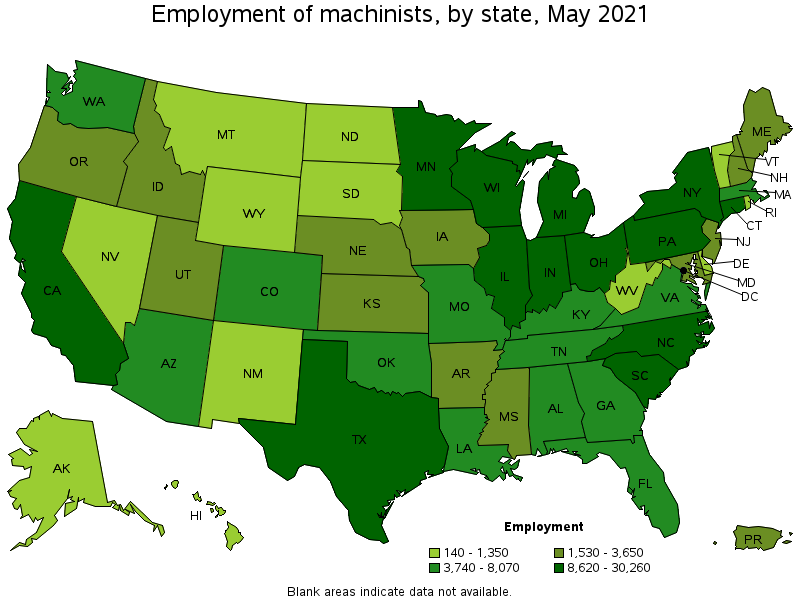
States with the highest employment level in Machinists:
| State | Employment (1) | Employment per thousand jobs | Location quotient (9) | Hourly mean wage | Annual mean wage (2) |
|---|---|---|---|---|---|
| Ohio | 30,260 | 5.82 | 2.46 | $ 21.42 | $ 44,560 |
| California | 29,810 | 1.80 | 0.76 | $ 25.02 | $ 52,040 |
| Michigan | 22,100 | 5.44 | 2.30 | $ 22.36 | $ 46,510 |
| Texas | 21,610 | 1.77 | 0.75 | $ 23.95 | $ 49,810 |
| Illinois | 20,510 | 3.65 | 1.54 | $ 23.64 | $ 49,160 |
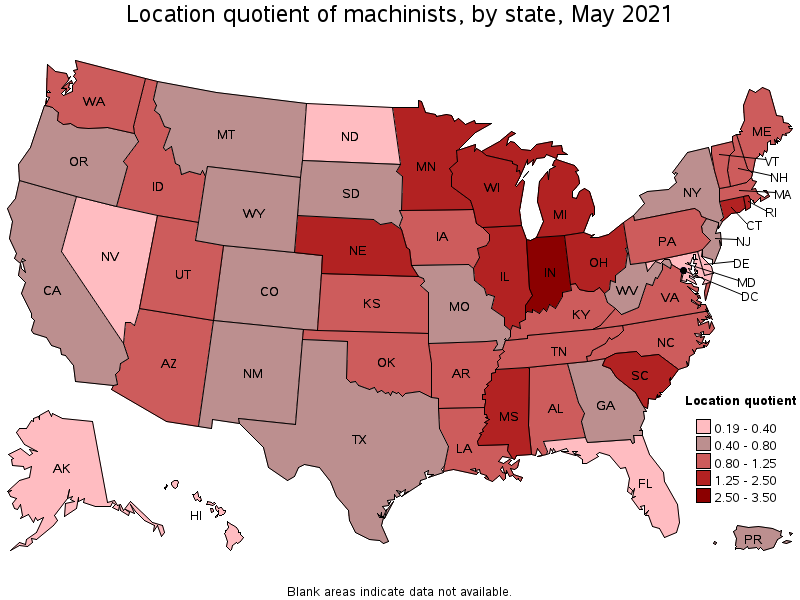
States with the highest concentration of jobs and location quotients in Machinists:
| State | Employment (1) | Employment per thousand jobs | Location quotient (9) | Hourly mean wage | Annual mean wage (2) |
|---|---|---|---|---|---|
| Indiana | 19,240 | 6.45 | 2.73 | $ 23.66 | $ 49,220 |
| Ohio | 30,260 | 5.82 | 2.46 | $ 21.42 | $ 44,560 |
| Connecticut | 8,620 | 5.48 | 2.32 | $ 26.80 | $ 55,750 |
| Michigan | 22,100 | 5.44 | 2.30 | $ 22.36 | $ 46,510 |
| South Carolina | 10,510 | 5.08 | 2.15 | $ 19.46 | $ 40,480 |
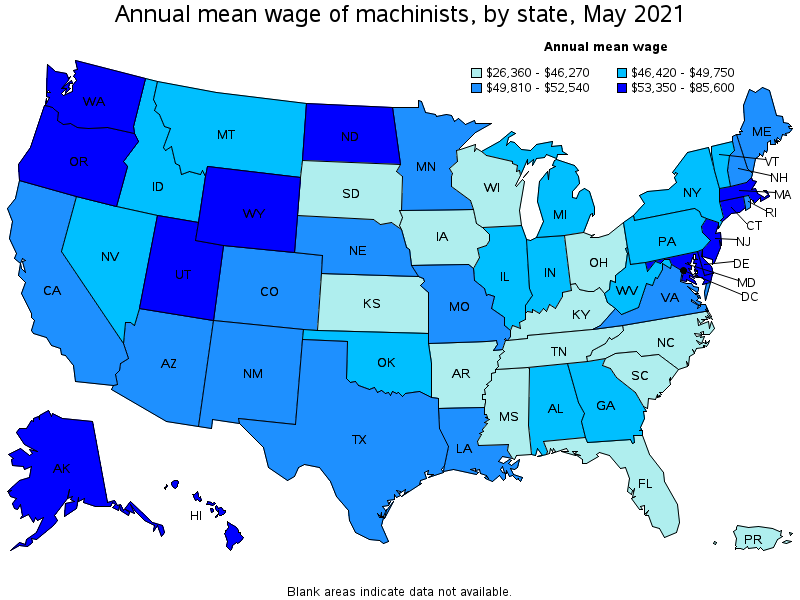
Top paying states for Machinists:
| State | Employment (1) | Employment per thousand jobs | Location quotient (9) | Hourly mean wage | Annual mean wage (2) |
|---|---|---|---|---|---|
| District of Columbia | 320 | 0.49 | 0.21 | $ 41.15 | $ 85,600 |
| Alaska | 140 | 0.48 | 0.20 | $ 34.10 | $ 70,920 |
| Hawaii | 250 | 0.46 | 0.19 | $ 34.02 | $ 70,760 |
| Washington | 6,850 | 2.14 | 0.90 | $ 28.89 | $ 60,080 |
| Maryland | 1,780 | 0.70 | 0.30 | $ 28.76 | $ 59,810 |
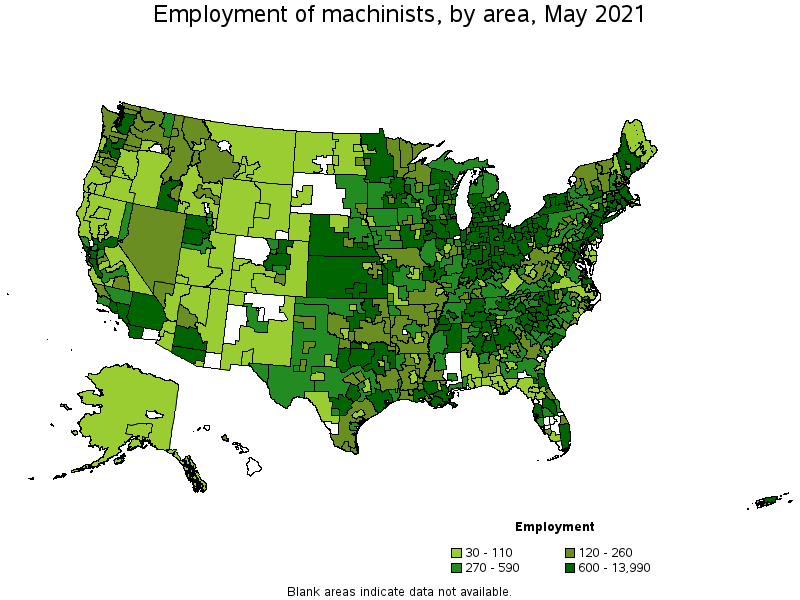
Metropolitan areas with the highest employment level in Machinists:
| Metropolitan area | Employment (1) | Employment per thousand jobs | Location quotient (9) | Hourly mean wage | Annual mean wage (2) |
|---|---|---|---|---|---|
| Chicago-Naperville-Elgin, IL-IN-WI | 13,990 | 3.31 | 1.40 | $ 24.63 | $ 51,220 |
| Los Angeles-Long Beach-Anaheim, CA | 12,140 | 2.12 | 0.90 | $ 23.76 | $ 49,420 |
| Detroit-Warren-Dearborn, MI | 8,470 | 4.70 | 1.99 | $ 23.56 | $ 49,000 |
| Houston-The Woodlands-Sugar Land, TX | 7,400 | 2.56 | 1.08 | $ 24.26 | $ 50,460 |
| Cleveland-Elyria, OH | 7,190 | 7.46 | 3.15 | $ 21.47 | $ 44,650 |
| Minneapolis-St. Paul-Bloomington, MN-WI | 7,020 | 3.85 | 1.63 | $ 26.07 | $ 54,230 |
| New York-Newark-Jersey City, NY-NJ-PA | 5,620 | 0.65 | 0.27 | $ 27.14 | $ 56,450 |
| Boston-Cambridge-Nashua, MA-NH | 5,110 | 1.98 | 0.84 | $ 27.52 | $ 57,230 |
| Dallas-Fort Worth-Arlington, TX | 5,040 | 1.40 | 0.59 | $ 23.43 | $ 48,730 |
| Cincinnati, OH-KY-IN | 4,810 | 4.70 | 1.99 | $ 23.13 | $ 48,120 |
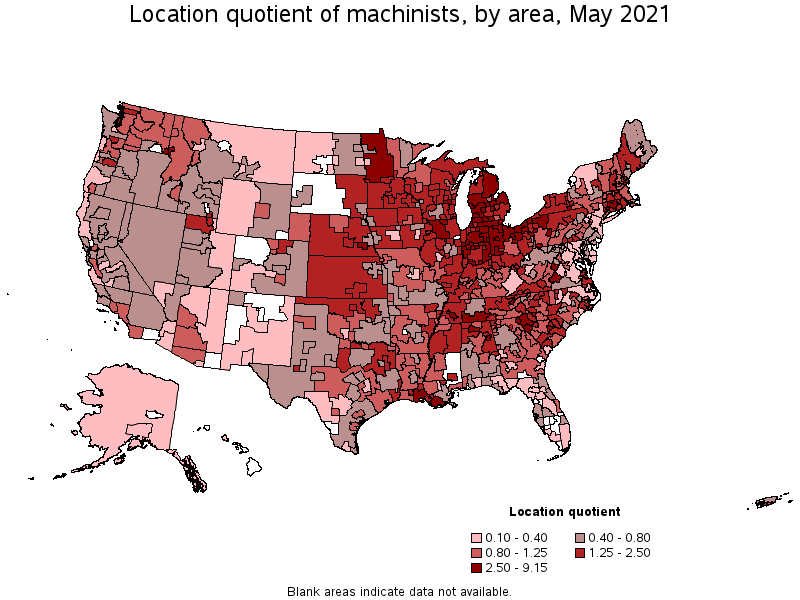
Metropolitan areas with the highest concentration of jobs and location quotients in Machinists:
| Metropolitan area | Employment (1) | Employment per thousand jobs | Location quotient (9) | Hourly mean wage | Annual mean wage (2) |
|---|---|---|---|---|---|
| Rockford, IL | 2,860 | 21.64 | 9.15 | $ 22.29 | $ 46,360 |
| Columbus, IN | 800 | 16.51 | 6.98 | $ 20.48 | $ 42,610 |
| Jackson, MI | 750 | 13.77 | 5.82 | $ 21.30 | $ 44,300 |
| Staunton-Waynesboro, VA | 590 | 12.73 | 5.38 | (8) | (8) |
| Elmira, NY | 380 | 11.64 | 4.92 | $ 22.95 | $ 47,730 |
| Niles-Benton Harbor, MI | 640 | 11.50 | 4.86 | $ 20.37 | $ 42,360 |
| Monroe, MI | 400 | 11.10 | 4.69 | $ 32.00 | $ 66,560 |
| Greenville-Anderson-Mauldin, SC | 4,340 | 11.06 | 4.68 | $ 18.16 | $ 37,770 |
| Sumter, SC | 390 | 10.97 | 4.64 | $ 19.06 | $ 39,650 |
| Fort Wayne, IN | 2,200 | 10.52 | 4.45 | $ 22.55 | $ 46,910 |
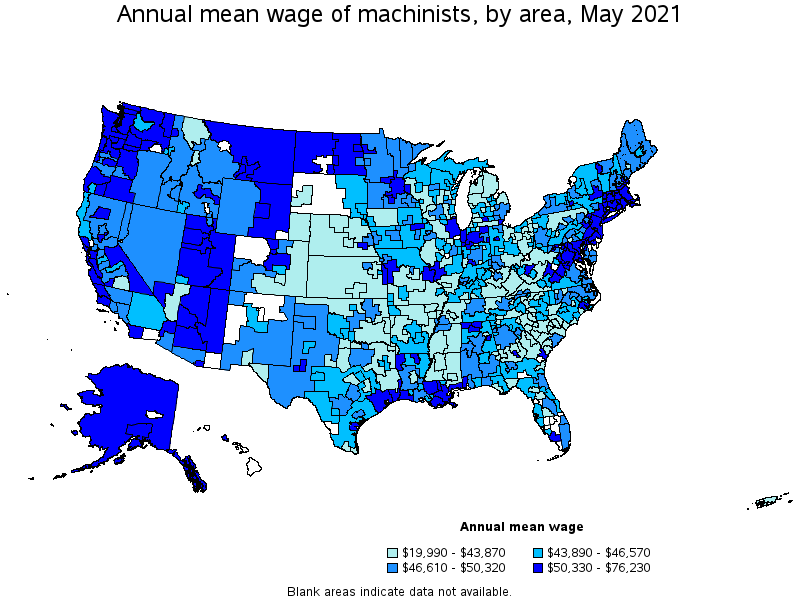
Top paying metropolitan areas for Machinists:
| Metropolitan area | Employment (1) | Employment per thousand jobs | Location quotient (9) | Hourly mean wage | Annual mean wage (2) |
|---|---|---|---|---|---|
| Urban Honolulu, HI | 230 | 0.59 | 0.25 | $ 34.17 | $ 71,070 |
| Washington-Arlington-Alexandria, DC-VA-MD-WV | 910 | 0.31 | 0.13 | $ 33.32 | $ 69,300 |
| Monroe, MI | 400 | 11.10 | 4.69 | $ 32.00 | $ 66,560 |
| Anchorage, AK | 40 | 0.27 | 0.11 | $ 31.49 | $ 65,500 |
| Bremerton-Silverdale, WA | 350 | 4.08 | 1.73 | $ 31.02 | $ 64,520 |
| Seattle-Tacoma-Bellevue, WA | 4,080 | 2.13 | 0.90 | $ 30.46 | $ 63,360 |
| California-Lexington Park, MD | 50 | 1.10 | 0.46 | $ 30.25 | $ 62,930 |
| Kennewick-Richland, WA | 110 | 0.94 | 0.40 | $ 30.17 | $ 62,750 |
| San Francisco-Oakland-Hayward, CA | 3,180 | 1.42 | 0.60 | $ 29.59 | $ 61,540 |
| Baltimore-Columbia-Towson, MD | 1,050 | 0.83 | 0.35 | $ 28.92 | $ 60,150 |
Nonmetropolitan areas with the highest employment in Machinists:
| Nonmetropolitan area | Employment (1) | Employment per thousand jobs | Location quotient (9) | Hourly mean wage | Annual mean wage (2) |
|---|---|---|---|---|---|
| West Northwestern Ohio nonmetropolitan area | 3,140 | 13.09 | 5.54 | $ 21.12 | $ 43,920 |
| Northern Indiana nonmetropolitan area | 3,100 | 15.16 | 6.41 | $ 25.76 | $ 53,570 |
| North Northeastern Ohio nonmetropolitan area (noncontiguous) | 2,950 | 9.39 | 3.97 | $ 20.50 | $ 42,640 |
| Balance of Lower Peninsula of Michigan nonmetropolitan area | 1,790 | 7.08 | 2.99 | $ 20.68 | $ 43,000 |
| Piedmont North Carolina nonmetropolitan area | 1,310 | 5.37 | 2.27 | $ 17.78 | $ 36,990 |
Nonmetropolitan areas with the highest concentration of jobs and location quotients in Machinists:
| Nonmetropolitan area | Employment (1) | Employment per thousand jobs | Location quotient (9) | Hourly mean wage | Annual mean wage (2) |
|---|---|---|---|---|---|
| Northern Indiana nonmetropolitan area | 3,100 | 15.16 | 6.41 | $ 25.76 | $ 53,570 |
| West Northwestern Ohio nonmetropolitan area | 3,140 | 13.09 | 5.54 | $ 21.12 | $ 43,920 |
| Upper Savannah South Carolina nonmetropolitan area | 890 | 11.42 | 4.83 | $ 19.38 | $ 40,300 |
| North Northeastern Ohio nonmetropolitan area (noncontiguous) | 2,950 | 9.39 | 3.97 | $ 20.50 | $ 42,640 |
| Northwest Illinois nonmetropolitan area | 1,080 | 8.54 | 3.61 | $ 21.05 | $ 43,790 |
Top paying nonmetropolitan areas for Machinists:
| Nonmetropolitan area | Employment (1) | Employment per thousand jobs | Location quotient (9) | Hourly mean wage | Annual mean wage (2) |
|---|---|---|---|---|---|
| Alaska nonmetropolitan area | 80 | 0.84 | 0.36 | $ 36.65 | $ 76,230 |
| Eastern Wyoming nonmetropolitan area | 110 | 1.32 | 0.56 | $ 28.62 | $ 59,530 |
| Eastern Washington nonmetropolitan area | 180 | 1.90 | 0.80 | $ 27.31 | $ 56,800 |
| Arizona nonmetropolitan area | 30 | 0.36 | 0.15 | $ 27.15 | $ 56,470 |
| Western Washington nonmetropolitan area | 130 | 1.11 | 0.47 | $ 26.84 | $ 55,840 |
These estimates are calculated with data collected from employers in all industry sectors, all metropolitan and nonmetropolitan areas, and all states and the District of Columbia. The top employment and wage figures are provided above. The complete list is available in the downloadable XLS files.
The percentile wage estimate is the value of a wage below which a certain percent of workers fall. The median wage is the 50th percentile wage estimate—50 percent of workers earn less than the median and 50 percent of workers earn more than the median. More about percentile wages.
(1) Estimates for detailed occupations do not sum to the totals because the totals include occupations not shown separately. Estimates do not include self-employed workers.
(2) Annual wages have been calculated by multiplying the hourly mean wage by a "year-round, full-time" hours figure of 2,080 hours; for those occupations where there is not an hourly wage published, the annual wage has been directly calculated from the reported survey data.
(3) The relative standard error (RSE) is a measure of the reliability of a survey statistic. The smaller the relative standard error, the more precise the estimate.
(8) Estimate not released.
(9) The location quotient is the ratio of the area concentration of occupational employment to the national average concentration. A location quotient greater than one indicates the occupation has a higher share of employment than average, and a location quotient less than one indicates the occupation is less prevalent in the area than average.
Other OEWS estimates and related information:
May 2021 National Occupational Employment and Wage Estimates
May 2021 State Occupational Employment and Wage Estimates
May 2021 Metropolitan and Nonmetropolitan Area Occupational Employment and Wage Estimates
May 2021 National Industry-Specific Occupational Employment and Wage Estimates
Last Modified Date: March 31, 2022